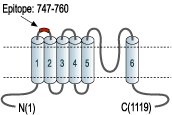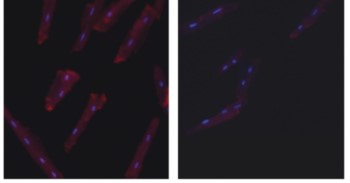Overview
- Peptide (C)NSTGIINETSDHSE, corresponding to amino acid residues 747-760 of human TRPA1 (Accession O75762). 1st extracellular loop.

 Western blot analysis of rat DRG (lanes 1,2), non-differentiated PC12 cells (lanes 3,5) and differentiated PC12 cells (lanes 4,6) lysates:1,3,4. Anti-TRPA1 (extracellular) Antibody (#ACC-037), (1:200).
Western blot analysis of rat DRG (lanes 1,2), non-differentiated PC12 cells (lanes 3,5) and differentiated PC12 cells (lanes 4,6) lysates:1,3,4. Anti-TRPA1 (extracellular) Antibody (#ACC-037), (1:200).
2,5,6. Anti-TRPA1 (extracellular) Antibody, preincubated with TRPA1 (extracellular) Blocking Peptide (#BLP-CC037).- Human urethra (1:2000) (Gratzke, C. et al. (2009) Eur. Urol. 55, 696.).
 Expression of TRPA1 in rat DRGImmunohistochemical staining of rat dorsal root ganglion (DRG) using Anti-TRPA1 (extracellular) Antibody (#ACC-037) (1:200). A. TRPA1 staining (green) is detected in both cells (horizontal arrow) and processes (vertical arrow). B. Nuclear staining using DAPI as the counterstain. C. Merged image of A and B.
Expression of TRPA1 in rat DRGImmunohistochemical staining of rat dorsal root ganglion (DRG) using Anti-TRPA1 (extracellular) Antibody (#ACC-037) (1:200). A. TRPA1 staining (green) is detected in both cells (horizontal arrow) and processes (vertical arrow). B. Nuclear staining using DAPI as the counterstain. C. Merged image of A and B.- Human urethra (1:500) (Gratzke, C. et al. (2009) Eur. Urol. 55, 696.).
 Expression of TRPA1 in rat PC12 cellsCell surface detection of TRPA1 in intact living rat PC12 cells. A. Extracellular staining of cells using Anti-TRPA1 (extracellular) Antibody (#ACC-037), (1:50) followed by goat anti-rabbit-AlexaFluor-594 secondary antibody (red). B. Live view of the cells. C. Merged image of A and B.
Expression of TRPA1 in rat PC12 cellsCell surface detection of TRPA1 in intact living rat PC12 cells. A. Extracellular staining of cells using Anti-TRPA1 (extracellular) Antibody (#ACC-037), (1:50) followed by goat anti-rabbit-AlexaFluor-594 secondary antibody (red). B. Live view of the cells. C. Merged image of A and B.
- Hill, K. and Schaefer, M. (2007) J. Biol. Chem. 282, 7145
- Story, G.M. et al. (2003) Cell 112, 819.
- Bandell, M. et al. (2004) Neuron 41, 849.
- Jordt, S.E. et al. (2004) Nature 427, 260.
- Zurborg, S. et al. (2007) Nat. Neurosci. 10, 277.
- Corey, D.P. et al. (2004) Nature 432, 723.
- Sotomayor, M. et al. (2005) Structure 13, 669.
- Clapham, D.E. (2002) Science 295, 2228.
The TRPA family is comprised of only one mammalian member, the TRPA1 (formerly named ANKTM1). TRPA1 is expressed in peripheral sensory neurons, where it is suggested to contribute to the detection of painful stimuli.1
Originally, it was thought that TRPA channels sensed painfully cold temperatures,2 but a more conservative description is that TRPA1 is sensitive to membrane/cytoskeletal perturbations caused by low temperatures3-5 and perhaps stretch.6 In addition, it is sensitive to pungent natural compounds present in cinnamon oil, mustard oil, and wintergreen oil.
TRPA1 is also expressed in hair cells, where its role in sensing mechanical forces is still unclear and controversial.1
TRPA1 has a similar structure to all other TRP ion channels; six transmembrane domains, intracellular N-and C-terminus. However, the N-terminal domain possesses 17 ankyrin repeats that might indicate its potential role as a mechanosensor.6,7
In addition, TRPA1 is expressed in nociceptive neurons expressing TRPV1 and might serve as a marker for polymodal nociceptors.8
Application key:
Species reactivity key:
Anti-TRPA1 (extracellular) Antibody (#ACC-037) is a highly specific antibody directed against an epitope of the human protein. The antibody can be used in western blot, immunoprecipitation immunohistochemistry, and live cell imaging applications. It has been designed to recognize TRPA1 from mouse, rat, and human samples.

Knockout validation of Anti-TRPA1 (extracellular) Antibody in mouse cardiomyocytes.Immunocytochemical staining of mouse cardiomyocytes using Anti-TRPA1 (extracellular) Antibody (#ACC-037). TRPA1 staining (red) is detected in cardiomyocytes from wild type mice (left panel). Lack of TRPA1 immunoreactivity is observed in TRPA1-/- cells (right panel).Adapted from Conklin, D.J. et al. (2019) Am. J. Physiol. 316, H889. with permission of The American Physiological Society.
Applications
Citations
 Expression of TRPA1 in rat DRGs.Immunohistochemical staining of rat DRG sections using Anti-TRPA1 (extracellular) Antibody (#ACC-037). TRPA1 staining (red) is detected in DRGs and co-localizes with IB4 staining (green).
Expression of TRPA1 in rat DRGs.Immunohistochemical staining of rat DRG sections using Anti-TRPA1 (extracellular) Antibody (#ACC-037). TRPA1 staining (red) is detected in DRGs and co-localizes with IB4 staining (green).
Adapted from Yamamoto, K. et al. (2015) Mol. Pain 11, 69. with permission of BioMed Central.
- Immunocytochemical staining of mouse isolated cardiomyocytes. Tested in TRPA1-/- mice.
Conklin, D.J. et al. (2019) Am. J. Physiol. 316, H889.
- Mouse heart lysate.
Conklin, D.J. et al. (2019) Am. J. Physiol. 316, H889. - Rat DRG lysate (1:200).
Yamamoto, K. et al. (2016) Mol. Pain 11, 69. - Mouse cerebral and cerebellar arteries lysate (1:500). Also tested in TRPA1 knock out mice.
Sullivan, M.N. et al. (2015) Sci. Signal. 8, 358. - Human cerebral arteries.
Sullivan, M.N. et al. (2015) Sci. Signal. 8, 358. - Human urethra (1:2000).
Gratzke, C. et al. (2009) Eur. Urol. 55, 696.
- Mouse cerebral and cerebellar arteries lysate 2 μg. Also tested in TRPA1 knock out mice.
Sullivan, M.N. et al. (2015) Sci. Signal. 8, 358. - Human cerebral arteries.
Sullivan, M.N. et al. (2015) Sci. Signal. 8, 358.
- Mouse and human heart sections.
Conklin, D.J. et al. (2019) Am. J. Physiol. 316, H889. - Rat trigeminal sections (1:100).
Meng, Q. et al. (2015) Am. J. Physiol. 309, C1. - Rat DRG sections.
Yamamoto, K. et al. (2015) Mol. Pain 11, 69. - Human urethra (1:2000).
Gratzke, C. et al. (2009) Eur. Urol. 55, 696.
- Mouse isolated cardiomyocytes. Also tested in TRPA1-/- mice.
Conklin, D.J. et al. (2019) Am. J. Physiol. 316, H889.
- Weinhold, P. et al. (2010) J. Urol. 183, 2070.


